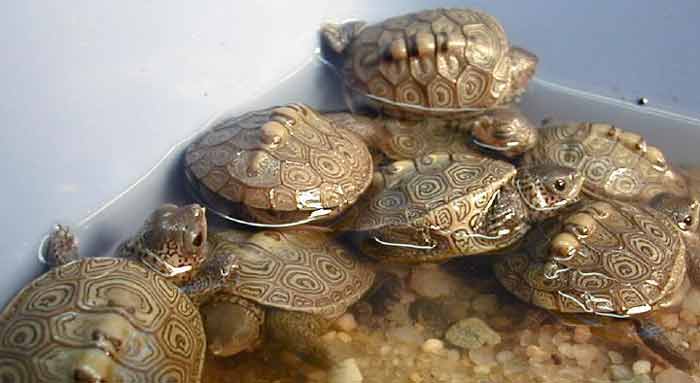Nick of Time — 28 August 2001
Serendipity came knocking and luckily someone was home to answer. On a lark this afternoon, I lifted faithful Rags into the jeep and bounced over the tinkertoy bridge to Lieutenant Island. With only a sandbox pail I scavenged from the winterís storm debris, we strolled the Turtle Point path between oceans of sea lavender and bearberry slopes. At the tip of the point, under shade of a lonely beach plum bush, a slit had opened since morning.
The first handful of dirt produced a shell shard discarded by an emerging hatchling en route topside, confirming this spot as Nest 168. The second scoop announced trouble. I pulled out a fistful of dirt littered with fly maggots and red ants. Working quickly I recovered shell remnants from 9 emerged hatchlings, 9 live babies pipped in the egg chamber and being attacked by these tiny predators, and 1 most unfortunate terrapin that had been killed by them. The maggots had slipped into the pipped shell and entered the hatchling through its yolk sac; the ants nipped around its cavities.
Most of the remaining hatchlings were already under attack. As I recovered each from the nest, I cleaned it of predators before placing it inside the bucket. Because they had so recently pipped, these hatchlings sported large yolk sacs which needed to be absorbed before they could be released into the marsh with any reasonable chance of survival. Thereís no question, though, that these turtles would not have survived the day had we not stumbled upon the scene.
We continued marsh patrol along the south Lieutenant Island wrack. As we reached Nest 030, which I had spot checked on Sunday evening, I spied a miniature turtle braced against the predator excluder. His companion occupied the opposite side of the cage. From this nest came a single hatchling preemie on the 26th, the two standing guard along the cage line, eight pipped inside the egg chamber, two eggs succumbed to root predation, and three remaining viable eggs.
All pipped hatchlings, including the eight from Nest 048 on Indian Neck, have fully emerged from their shells. With large yolk sacs still to absorb, they have been placed in a moist, marshy nursery tank for a couple of days. Despite its roominess, hatchlings seem to yearn for the crowded warmth of the clutch as they arrange floating bunk beds for the night.

|